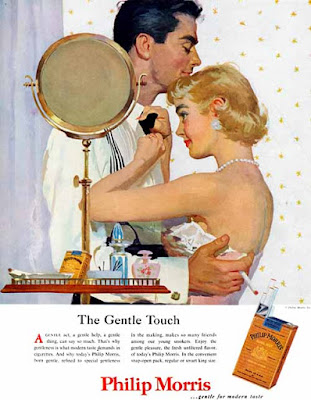When Joe Bowler (1928-2016) was just starting out as an illustrator he got a job as an apprentice for the legendary Cooper Studios in New York.
Illustration by Joe Bowler
But he wanted to do more than just cut mats and wash out brushes for the master illustrators. He hoped to prove himself as a full-fledged artist.
So he hung out in the bullpen to watch how master illustrators like Coby Whitmore produced their paintings.

It was a revelation for Bowler to watch the way Coby Whitmore painted. Bowler said that Coby "would paint an illustration from beginning to end in about forty-five minutes, talking the whole time and I'd be watching every stroke, every mixture of paint just watching him work. Every color he put down on his palette, the way he applied the paint. That was my education really."
Illustration by Coby Whitmore
Still in his early twenties, Bowler was getting a practical education from the best painters in the business.
But he thought he should enroll in art school to get a better grounding. So he went to the Art Students League, where one of the main instructors was Frank Reilly.
(Frank Reilly conducting a class)
Bowler recalls: "I was going to night school at the Art Students League -- the Frank Reilly class in drawing I thought, well I guess I'll go sign up for his painting class too."
"In the middle of the first day of class, he started to tell everybody about the way to mix colors. He had this incredibly graduated value scale he was running down... and I finally put up my hand and said, 'That's not the way they do it.'"
"Reilly said, 'Oh, really?' and I said, 'Yeah, I'm working at the Cooper Studio.' And he said, 'Oh really? Well I guess you'd better just go and work there some more.' He literally kicked me outta the place."

Illustration by Joe Bowler
"Fifteen, twenty years later - the phone rings and it's Frank Reilly! He says. "Oh Joe, how are you? I'm just finishing up my book and putting the names of some of my more famous students in there...and I see your name is there, but I don't really remember too much about you."
Bowler said, "He asked me if he could use my name in his book and I said sure."
----













7 comments:
Great story. So...the caption with the second image... Joe (Double Bang) Bowler. Does the Illustration Magazine feature give the basis for the nickname?
Sounds like a missed opportunity . If Mr. Reiley had been a little less insecure, or a little more curious, he would have asked, "How are they doing it", and Joe could have presented his information. A general discussion on the merits of each process could have taught everyone much more.
I love this blog so much and truly appreciate your artistic generosity. But something about this anecdote just rubs me wrong. It’s framed as ‘Bowler was right (and practical) so the system (a formal education) was wrong’
There are many ways of doing things, just because Reilly’s way was different than the Cooper studio doesn’t negate what Reilly had to offer. Arts education has to cover so many different approaches, not all will appeal to everyone or every way of doing things.
Courbet, it's one person's story and one person's experience, and you don't have to draw that broadly negative conclusion. On other blog posts I've shared a lot about Reilly's positive contribution to teaching. You're right: there are many ways to make a painting. In fact Reilly's method influenced a whole generation of working illustrators, such as James Bama.
But I liked Bowler's story because it calls attention to a set of potential pitfalls that all art schools can face to varying degrees:
1) Art schools sometimes preferentially hire their own graduates and miss out on fresh ideas or conflicting ideas because of that;
2) Those teachers don't necessarily have practical experience learned in the business, and often trade on useless theory; and
3) Teachers sometimes give busywork assignments that make a task harder than it has to be.
Of course there are many art schools that have skilled professionals who teach efficient methods that work in the real world, and more power to them. But three cheers to Joe Bowler for discovering that he was getting gold directly from the mine, and getting paid to learn.
It's a great story, but did Frank Reilly actually publish a book? I'm aware of publications by various of his students that claim to teach the Reilly method--e.g., books by Angelo Grado, Jack Faragasso, Doug Higgins, Ralph Garafola and a few others--but if Reilly himself ever published, I'm unaware of it and would sure like to find a copy.
Robert, as far as I know Frank Reilly never produced a book. There are a few articles by him, and he made a series of short films about Cornwell and others. But most of the books are by his students. Apollo Dorian wrote a very detailed and technical account (prob hard to find) called Values for Pictures Worth a Thousand Words. Jack Faragasso is still with us, and you can meet him on Facebook.
The Joe Bowler Chronicles site is terrific. Thanks!
Post a Comment